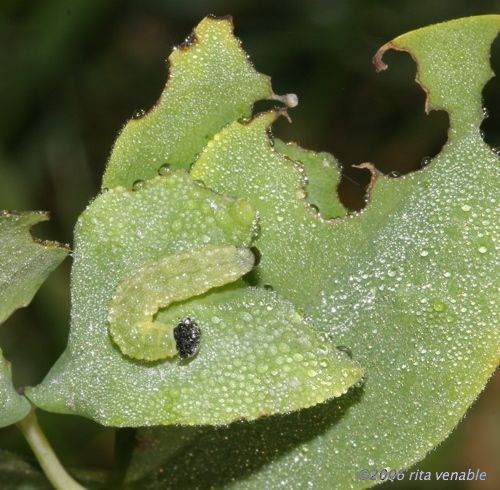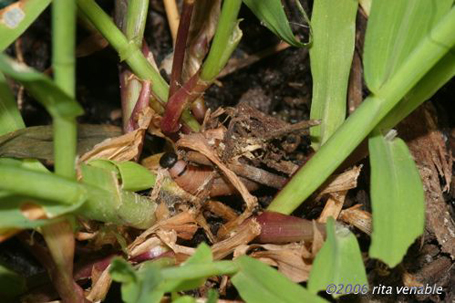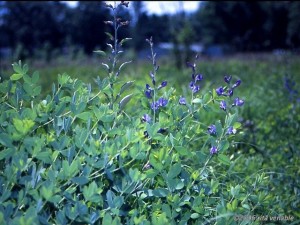Sunlight was just peaking around the corner of my house this morning as I was inspecting the plants on the back porch. It had been a chilly night, in the 40s. Why did the Wild Indigo Duskywing caterpillar choose to sleep outside in the cold air instead of its sheltered leaf-house? I don’t know, but it was covered with dew when I found it this morning.
The little Sachem caterpillar, which is still living at the base of the crabgrass in the container I have provided for it. Today, it seemed there was more silk around the caterpillar. It was woven in with debris, dead grass and soil to surround the skipper. It has been 29 days since it hatched.
It wasn’t out in the open like this picture shows, in fact, it is hard to locate each day. I lift up the crabgrass ever so gently with a toothpick until I see the body of the caterpillar, shoot a photo or two and put it back, trying not dislodge it, or disturb it unnecessarily.
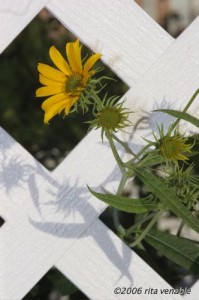 On another note, I was very glad to notice that the whorled sunflower (Helianthus verticillatus) that a friend grew from seed and gave to me is blooming for the first time in my garden. The whorled sunflower is a rare species in Tennessee, in fact, there are only four known populations in the Southeast. I put the pot inside a lattice for protection, and lo and behold, it took to the location light-wise, so I decided to plant it there. Unfortunately, last year, someone accidentally crushed part of it, but it came back fine this year and now is blooming heartily.
On another note, I was very glad to notice that the whorled sunflower (Helianthus verticillatus) that a friend grew from seed and gave to me is blooming for the first time in my garden. The whorled sunflower is a rare species in Tennessee, in fact, there are only four known populations in the Southeast. I put the pot inside a lattice for protection, and lo and behold, it took to the location light-wise, so I decided to plant it there. Unfortunately, last year, someone accidentally crushed part of it, but it came back fine this year and now is blooming heartily.
Another friend had given me wild indigo (Baptisia australis) seed a while ago from his property near Hohenwald, and after soaking the seed in water for a while to help soften the hard seed coat, I had planted several in little containers for later transplanting into the garden. I had four of them and was planning on sharing three with Owl’s Hill Nature Sanctuary when someone could come by and get them. The wild indigo is a native plant to Tennessee which likes moist/dry, full sun/part shade locations. It likes alkaline soils, which suits my Central Basin location just fine. I do not have a big yard, but would like to try at least one plant here, since it is the host plant for the Wild Indigo Duskywing, a butterfly some consider interesting. I might plant it around our air-conditioning unit where it stays moist even in the heat, in fact, the hotter it gets, the more the air conditioner runs, and the more water it puts out around it. Maybe it will make it there. The fact that wild indigo tends to become rather “leggy” will also keep it from being too prominent in the landscape around the yard. Here’s what the plant looks like when full-grown. The photo was taken at May Prairie in Coffee County, TN. My plants are only a few inches high.
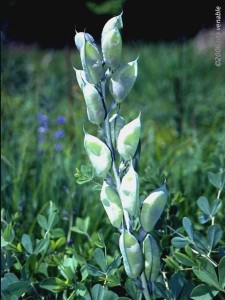 A week or two ago, when the plants were about six inches high, a Wild Indigo Duskywing female flew in and laid several eggs on the leaves of the small plants. This was surprising to me since the plants were so little; how on earth did she find them? There was no other wild indigo around. It seemed amazing to me that her sense of detection for the correct food plant was so acute. The eggs hatched in a few days and three little caterpillars began to munch on the wild indigo. This did not bother me, as the plant dies back in the winter anyway, and the roots are the most important thing to transplant. The more pressing question was: Would there be enough food for them to eat?
A week or two ago, when the plants were about six inches high, a Wild Indigo Duskywing female flew in and laid several eggs on the leaves of the small plants. This was surprising to me since the plants were so little; how on earth did she find them? There was no other wild indigo around. It seemed amazing to me that her sense of detection for the correct food plant was so acute. The eggs hatched in a few days and three little caterpillars began to munch on the wild indigo. This did not bother me, as the plant dies back in the winter anyway, and the roots are the most important thing to transplant. The more pressing question was: Would there be enough food for them to eat?
©Rita Venable 2006
